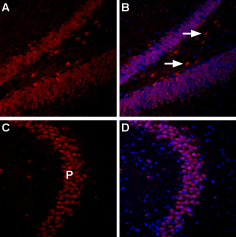Overview
- Peptide (C)HREMQVSDRVRSIAKD, corresponding to amino acid residues 337-352 of rat OPRL1 (Accession P35370). Intracellular, C-terminus.
- Mouse brain sections (1:60).
 Expression of Nociceptin receptor in mouse hippocampusImmunohistochemical staining of mouse hippocampus using Anti-Nociceptin Receptor (OPRL1)-ATTO Fluor-594 Antibody (#AOR-015-AR), (1:60). A, B. Nociceptin receptor staining (red) in hippocampal dentate gyrus (DG) appears in the outlines of neuronal cell bodies in the granule layer and in the hilus (arrows). C, D. Nociceptin receptor staining in hippocampal CA3 region appears in the outlines of neuronal cell bodies in the pyramidal layer (P). Nuclei are stained using DAPI as the counterstain.
Expression of Nociceptin receptor in mouse hippocampusImmunohistochemical staining of mouse hippocampus using Anti-Nociceptin Receptor (OPRL1)-ATTO Fluor-594 Antibody (#AOR-015-AR), (1:60). A, B. Nociceptin receptor staining (red) in hippocampal dentate gyrus (DG) appears in the outlines of neuronal cell bodies in the granule layer and in the hilus (arrows). C, D. Nociceptin receptor staining in hippocampal CA3 region appears in the outlines of neuronal cell bodies in the pyramidal layer (P). Nuclei are stained using DAPI as the counterstain.
Nociceptin/orphanin FQ (N/OFQ), a 17 amino acid peptide, is the endogenous agonist of the nociceptin/orphanin FQ peptide (NOP) receptor (previously termed ORL1 receptor) which belongs to the class A (Rhodopsin-like) γ subfamily of G protein-coupled receptors (GPCRs). Like all members the receptor has a common seven-transmembrane helical structure and is coupled predominantly to heterotrimeric Gi/Go proteins. N/OFQ receptor shows a high degree of structural homology with the μ-, δ- and κ-opioid receptors1. The intracellular events triggered by the binding of N/OFQ with the NOP receptor include inhibition of adenylyl cyclase, activation of phospholipase C (PLC) and of K+ channels, inhibition of Ca2+ channels, and activation of mitogen-activated protein-kinases (MAPKs). In neural tissues, the main effect is the inhibition of the release of neurotransmitters (acetylcholine, catecholamines, GABA, glutamate, 5-hydroxytryptamine, tachykinines)2.
NOP receptor mRNA is detected in high levels in the cortex, anterior olfactory nucleus, lateral septum, hypothalamus, hippocampus, amygdala, central grey, pontine nuclei, interpeduncular nucleus, substantia nigra, raphe complex, locus coeruleus and spinal cord3.
Studies with N/OFQ, NOP-selective agonists or antagonists, and receptor- or peptide-deficient mice have shown that the NOP system has important roles in the control of central and peripheral functions including pain, anxiety depression, hyperphagia and obesity, addiction, Parkinson's disease, cognition, food intake, learning and memory, locomotion, cough and micturition reflexes, cardiovascular homeostasis, intestinal motility and immune responses4.
